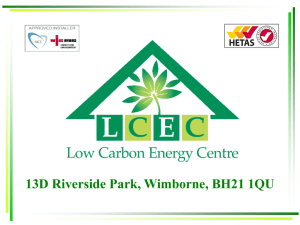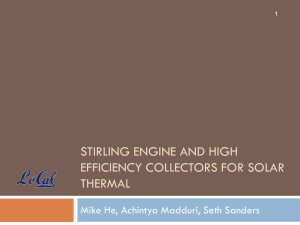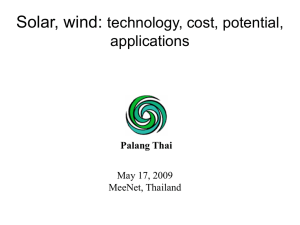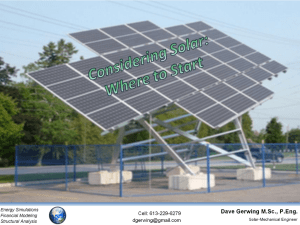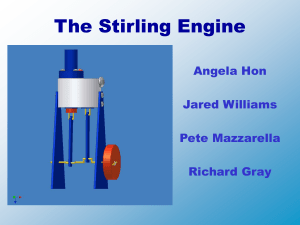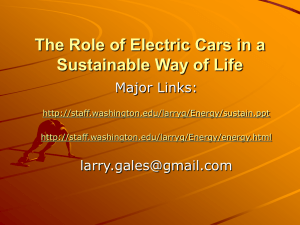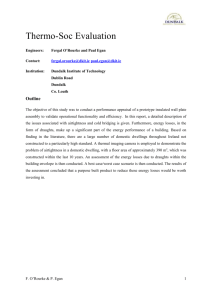Distributed Solar-Thermal-Electric Generation and Storage
advertisement
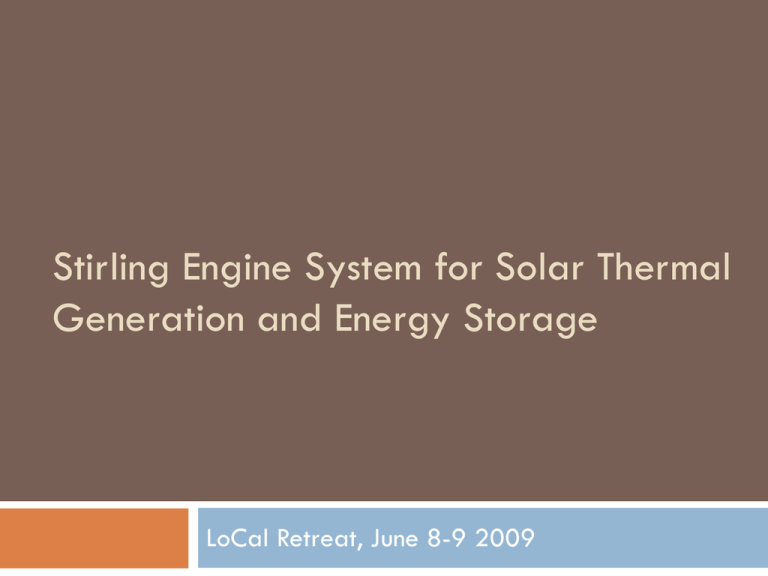
Stirling Engine System for Solar Thermal Generation and Energy Storage LoCal Retreat, June 8-9 2009 Outline Overview/Motivation System Description Early Prototypes Higher Power Engine Design Thermal Energy Applications Solar Thermal Dispatchable Generation Low cost, simple manufacturing Thermal Storage Dispatchable Resource Low capital cost Waste Heat Recovery Free energy source – Industrial Processes, Combined Cycle Low Temperature Renewable Energy Challenges Renewable Energy Challenges Solar Thermal Advantages Cost Lower Cost Intermittency Inherent Storage Production bottlenecks Simple Manufacturing Versatility Intermittency and Energy Storage 4.6 MW Solar Installation 1.5 MW Wind Turbine Source: J. Apt, A. Curtright, “The Spectrum of Power from Utility-Scale Wind Farms and Solar Photovoltaic Arrays”, CEIC 2008 Cost Comparison Solar Thermal Component Collector Engine Balance of System Total Energy Storage Thermal Source: PV data from Solarbuzz Photovoltaic $/W 0.34 0.5 3.6 4.44 $/kWh 20 Component PV Module Inverter Balance of System Total Energy Storage Batteries $/W 4.70 0.72 3.6 9.02 $/kWh 2030 Solar System Schematic Stirling Engine Can achieve large fraction (60-70%) of Carnot efficiency Low cost, simple components Fuel Flexible Reversible Scalable engine and storage capacity Stirling Cycle Overview 4 1 2 3 Research Designed, built, tested two low power prototypes Single phase and multiphase machines Low power Verified engineering models Design of high power prototype Improved simulation and design Heat exchanger design Optimization of geometry, parameters Prototype 1: Single Phase Gamma-Type Free-Piston Stirling Displacer Temperatures: Working fluid: Frequency: Pistons – Stroke: – Diameter: Indicated power: – Schmidt analysis – Adiabatic model Power piston Th=175 oC, Tk=25 oC Air @ ambient pressure 3 Hz 15 cm 10 cm 75 W (thermal input) - 25 W (mechanical output) 254 W (thermal input) - 24 W (mechanical output) Prototype Operation Power Breakdown (W) Indicated power 26.9 Gas spring hysteresis 10.5 Expansion space enthalpy loss 0.5 Cycle output pV work 15.9 Bearing friction and eddy loss 1.4 Coil resistive loss 5.2 Power delivered to electric load 9.3 Piston Systems Prototype 2: Multi-phase Nylon flexure (cantilever spring) Axis of rotation Actuator mounting jaw Sealed clearance Cooler Heater Diaphragm Cold side piston plate Components Experimental Data Parameter Value Working fluid Ambient air Frequency ~30 Hz Hot side temperature 147 oC Cold side temperature 27 oC Power (per phase) 12.7 W Calculated damping (per phase) 19.5 W Dominant damping (per phase) Gas hysteresis (10.8 W) Gas Compression Loss Reverser More Phases => Less Compression High Power Design Design Characteristics Nominal Power Output Thermal-Electric Efficiency Fraction of Carnot Efficiency Hot Side Temperature Cold Side Temperature Pressure Engine Frequency Regenerator Effectiveness Total Heat Exchanger Flow Loss Regenerator Flow Loss Compression Loss Hot Side Heat Exchanger Temp Drop Cold Side Heat Exchanger Temp Drop Value 2.525 kW 21.5% 65% 180 oC 30 oC 25 bar 20 Hz 0.9967 54.5 W 166.6 W 66.8 W 2.74 oC 3.01 oC Energy Flows and Losses Regenerator Ineffectiveness Heat Transfer Leakages Heat In Heater Ideal Stirling Cycle Heater and ½ Regenerator Flow Loss Cooler Cooler and ½ Regenerator Flow Loss Rejected Heat Internal Bearing & Motion Losses PV Work Out Gas Hysteresis Loss Electrical Output Alternator Inefficiency, Bearing Losses Differences from prototypes Design Improvements Improved heat exchanger design Refined simulation and models Extensive optimization Scaling Increased pressure Increased frequency Increased volume Relatively smaller losses Efficiency and Power Output Contour Plot 20Hz, 25bar Air Efficiency and Power (W) 0.215 30 00 25 00 00 20 15 0.2 0.05 0.045 00 15 Power Piston Stroke (m) 00 30 0 15 0 0.06 0.055 5 0.21 21 0. 5 21 . 0 0.04 0.035 35 00 0.2 1 1 0.2 00 25 0 20 0 0.065 0. 20 5 0.07 15 00 25 0 0 20 00 1 0.2 05 0.2 0.2 20 00 95 0.1 2 10 . 0 05 0.19 0.21 00 0.2 15 00 0.03 0.008 0.009 0.01 0.011 0.012 0.013 0.014 0.015 0.016 0.017 0.018 Displacer Stroke (m) What’s Next? Finalize designs Fabrication and testing of high power prototype Design/experimental work with thermal storage Explore waste heat electric generation Economic analysis of cogen, energy storage opportunities Residential Example 30-50 sqm collector => 3-5 kWe peak at 10%eff Reject 12-20 kW thermal power at peak. Much larger than normal residential hot water systems – would provide year round hot water, and perhaps space heating Hot side thermal storage can use insulated (pressurized) hot water storage tank. Enables 24 hr electric generation on demand. Another mode: heat engine is bilateral – can store energy when low cost electricity is available Thermal Storage Example Sealed, insulated water tank Cycle between 150 C and 200 C Thermal energy density of about 60 W-hr/kg, 60 W-hr/liter Considering Carnot (~30%) and non-idealities in conversion (50-70% eff), remain with 10 W-hr/kg Very high cycle capability Cost is for container & insulator Collector and Engine Efficiency G = 1000 W/m2 (PV standard) Schott ETC-16 collector Engine: 2/3 of Carnot eff. Energy Storage Comparison Storage Technology Energy Density Cost Self-discharge Round Trip Efficiency Lifetime Thermal (various media) 20-80 kWh/m3 $40-65/ kWh 1-2% per day 70-80% Unlimited Flywheel Compressed Air 0.2 Wh/kg 2 kWh/m3 Minimal None 80-90% 80% ~20 years Unlimited Superconducting Magnetic Energy Storage 1-10 Wh/m3 $300/kWh $1-5/kWh (storage only) $54,000/kWh None with cooling 90-95% Unlimited Pumped Hydro 0.3 kWh/m3 @ 100m $10-45/kWh None 75% Unlimited NiMH Battery NiCad Battery Lithium Ion Battery 30–80 Wh/kg 40-60 Wh/kg 160 Wh/kg $364/kWh $400/kWh $300/kWh 30%/month 20%/month 5%/month 66% 70-90% 99.90% 500-1000 cycles 1500 cycles 1200 cycles Lithum Polymer Battery 130-200 Wh/kg $500/kWh 10%/month 99.50% 1000 cycles Lead Acid Battery 30-40 Wh/kg $100-200/kWh 3%-4%/month 70%-92% 500-800 cycles
